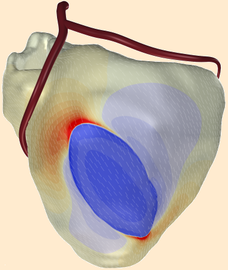IEEE Trans. Biomed. Eng. 53(12):2425-2435, 2006.
acknowledgement
Dr Gulrajani died unexpectedly in April 2004. We gratefully dedicate this paper to his memory.
links
full text from the publisher's website
context
This paper describes the bidomain version of our model. It was the first bidomain reaction-diffusion model of the entire human heart that could actually simulate a whole heart beat. It is also one of the few reaction-diffusion models of the entire human heart.
The model anatomy was the same as in the Lorange-Gulrajani model, but with a much higher resolution (0.2 mm), and a new method to determine fiber orientation such that fibers now align with the endocardial and epicardial surfaces.
The code of the model itself is a thoroughly revised version of the monodomain reaction-diffusion model created by Marie-Claude Trudel and Bruno Dubé, to which bidomain code was added. After much experimentation, we decided on a BiCGStab linear-system solver and an ILU preconditioner. Domain decomposition was used to allow the preconditioner to work efficiently on parallel computers. An important factor in the success of this program is the method to discretize the diffusion operators, which was based on work by Saleheen and Ng.
As an application of this model, we compared results of monodomain and bidomain propagation models. We found that the differences were negligible on the scale of a whole human heart. For such simulations, a monodomain model is usually good enough (and much faster). Bidomain propagation models are only necessary when extracellular stimulation or defibrillation shocks are modeled, which is in fact what most researchers using bidomain models are concentrating on. In addition, a bidomain solver (but not a bidomain propagation algorithm) is needed to simulate intracardiac electrograms. We have used this capability of our model in later work on measurement methods for myocardial repolarization.
The design of the model is very flexible: for each of the (60 million) model points a choice can be made between different membrane models and their parameters, and for each point the tissue conductivity values can be set. Fiber orientation can also be different at each point.
abstract
A bidomain reaction-diffusion model of the human heart was developed, and potentials resulting from normal depolarization and repolarization were compared with results from a compatible monodomain model. Comparisons were made for an empty isolated heart and for a heart with fluid-filled ventricles. Both sinus rhythm and ectopic activation were simulated. The bidomain model took 2 days on 32 processors to simulate a complete cardiac cycle. Differences between monodomain and bidomain results were extremely small, even for the extracellular potentials, which in case of the monodomain model were computed with a high-resolution forward model. Propagation of activation was 2% faster in the bidomain model than in the monodomain model. Electrograms computed with monodomain and bidomain models were visually indistinguishable. We conclude that, in the absence of applied currents, propagating action potentials on the scale of a human heart can be studied with a monodomain model.
funding
This work was supported by the Natural Sciences and Engineering Research Council of Canada. The work of M. Potse was supported in part by FRSQ, Québec, and in part by The Netherlands Organization for Scientific Research (NWO). Computational resources for this work were provided by the Réseau québécois de calcul de haute performance (RQCHP).
